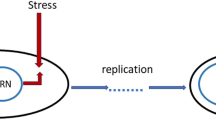Abstract
The study of a multiagent system generating a new function was carried out. A coordinate solution, such as the multiagent system, is effective for complicated problems. Therefore, it is necessary for agents to behave systematically while building cooperative relations with each other. We pay attention to an entrainment phenomenon which can be seen in life phenomena, such as cardiac muscle cells or the emission of light by a firefly, as an element to promote organized behavior between agents. We suggest a new system model unlike conventional systems.
Similar content being viewed by others
Explore related subjects
Discover the latest articles, news and stories from top researchers in related subjects.References
Tokashi I, Yoshihisa F (1999) An adventure to the frontier of knowledge. NTT Press
Ueda K (2007) Creative action and a multi-agent system. Baifukan, Tokyo
Masayasu M, Yuki K (2005) The world of rhythm phenomena. University of Tokyo Press
Ryuichi K (2002) A study on dependency of parameters for nonlinear oscillators (in Japanese). Bachelor thesis
Hiroyuki N, Yoshikazu B (1992) A guide to chaos analysis. Mathematical principle of a phenomenon. Baifukan
Waseda University (2007) The complexity of systems in a high scientific research center. Kyoritsu shuppan
Hiroto K (2001) A simple model of coupled oscillation and multiagent simulation of synchronization (in Japanese). Yamagata Coll Indust Technol J 7:38–44
Tomoaki K, Mihiro M, Toru M (1998) Models of relational adaption in mutual interference system and application of adaptive mechanism to cooperative walker-agents (in Japanese). Japan Society of Mechanical Engineers Collection of lecture papers Vol 98
Yoichiro N, Tomoshi O, Kazuhiro O, et al (1996) Self-organization model of cooperative relationships between agents (reinforcement learning by globally coupled chaotic system) (in Japanese). Japan Society of Mechanical Engineers Collection of lecture papers 96(2):730–733
Toshihiko K, Hideki S, Yoshio I, et al (2000) The study of synchronous flashing of fireflies using cellular automata (in Japanese). Japan Society of Mechanical Engineers Collection of calculation dynamics lecture papers, pp 183–184
Toshihiko K, Hideki S, Yoshio I (2001) Simulation of synchronous flashing of fireflies using cellular automata (in Japanese). Japan Society of Mechanical Engineers Collection of the Hokuriku Shinetsu branch general meeting lecture papers, pp 135–136
Author information
Authors and Affiliations
Corresponding author
Additional information
This work was presented in part at the 14th International Symposium on Artificial Life and Robotics, Oita, Japan, February 5–7, 2009
About this article
Cite this article
Asano, H., Suzuki, H., Uchida, M. et al. Basic examination concerning multiagent cooperation with entrainment. Artif Life Robotics 14, 71–75 (2009). https://doi.org/10.1007/s10015-009-0631-z
Received:
Accepted:
Published:
Issue Date:
DOI: https://doi.org/10.1007/s10015-009-0631-z




